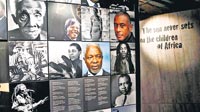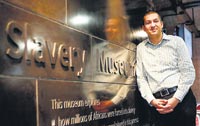
Slavery: Resistance amid the horrorLIVERPOOL: The riverside docks here, now a gentrified quarter, were a critical pivot in the trans-Atlantic slave trade when this city rose from seedy port to rich entrepôt in the 17th century. From Liverpool, traders sailed forth with guns and metals to sell in Africa, and from the proceeds bought slaves for the flourishing markets in the Americas. After the merchants sold their human cargo, their ships returned home brimming with sugar, cotton, coffee and tobacco. To commemorate and, more important, elucidate this dark passage of the city's past, the International Slavery Museum opened here Thursday, part of a series of events across Britain on the bicentenary of the 1807 British law that banned the slave trade. But rather than focus on the local story, Richard Benjamin, who directs the new museum and is a Briton of Guyanese descent, takes a different tack. Under his guidance, some of the museum exhibits thrust the visitor directly into the cultures of West Africa, emphasizing that many slaves came from a proud heritage that continues to thrive. Its aim is to be an educational institution rather than primarily a repository of important artifacts.
Benjamin, 35, who recently earned his doctorate at the University of Liverpool, has explored black identity through the prism of archaeology in his scholarly work. Based on that research, and his interest in being a mentor to Liverpool students from diverse ethnic backgrounds, he says he wants the museum to be a tool for "empowerment." "If I had to choose one word for the museum, it would be resistance," he said as he escorted a visitor past displays that were being given last-minute touches by curators. "Trans-Atlantic slavery was not such a passive thing. Africans kept their culture. We want to educate people to understand that black people does not equal 'oppression.' " The first gallery offers an introduction to Ghana. Musical instruments, elaborate wood carvings and a re-creation of the domestic quarters of an extended Ibo family give an idea of the origins of some slaves captured there. Next, visitors contemplate the voyage from Africa to the New World, a brutal journey of 8 to 12 weeks known as the Middle Passage. Rather than exhibit a mock-up of a slave vessel - a feature of an old display on slavery in Liverpool - he commissioned a video to be shown on four screens. In jarring images, it shows what it was like for the slaves as they lurched about in suffocating and stinking conditions - often in leg irons, often flogged and often afflicted by dysentery or other maladies. "It has to be in your face; we don't want to skirt any issues," Benjamin said. A theme of the video is taken from a description from a ship's surgeon who wrote, "The deck that is the floor of their rooms was so covered with the blood and mucus which had proceeded from them in consequence of the flux, that it resembled a slaughterhouse." The third gallery addresses slavery and the legacy of racism. A large oil painting completed as the Civil War began in America in 1861, "The Hunted Slaves" by Richard Ansdell, shows two runaway slaves, a frightened woman and an ax-wielding man, trying to fend off dogs that have been set on them by the slaves' owners. A display case shows the white cotton uniform of a Ku Klux Klansman, complete with a peaked hood, a face mask, long sleeves, a row of buttons down the front, and food stains that signal that it did not just hang in a closet. The most striking factor may be its provenance: the original owner used it in 1920 in Port Jervis, New York, which sits at a junction for New York, New Jersey and Pennsylvania. "This is not from the South," Benjamin said. "It shows that the Klan was in the North." The museum acquired the artifact after a collector called and asked if Benjamin would be interested in it, said Angela Robinson, a museum curator who authenticated the robe after meeting the donor at his home in Britain.
"He collected Americana, but he was a bit uncomfortable with it," she said. The collection concludes with a wall of photographs of black men and women who, Benjamin said, have stood up and resisted. The choices range from Nelson Mandela and Desmond Tutu, fighters against South African apartheid, to novelists like Caryl Phillips and Toni Morrison to the 18th-century chronicler Olaudah Equiano, shown with well-coiffed hair and a fine red jacket. A slave born in Benin who managed to get an education and enter British society, Equiano wrote "The Interesting Narratives of the Life of Olaudah Equiano," a gripping account from 1789 of life as a slave. It became a rallying call for the abolitionists. "The closeness of the place and the heat of the climate, added to the number in the ship, which was so crowded that each had scarcely room to turn himself, almost suffocated us," Equiano wrote. "This produced copious perspirations, so that the air soon became unfit for respiration from a variety of loathsome smells, and brought on a sickness among the slaves, of which many died, thus falling victims to the improvident avarice, as I may call it, of their purchasers." It is the forgotten heroes like Equiano who Benjamin hopes will inspire visitors. Courtesy International Herald Tribune |
|| Front
Page | News | Editorial | Columns | Sports | Plus | Financial
Times | International | Mirror | TV
Times | Funday
Times || |
| |
Copyright
2007 Wijeya
Newspapers Ltd.Colombo. Sri Lanka. |

